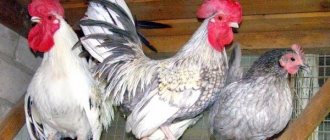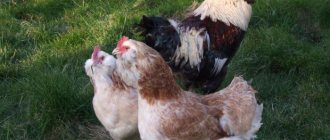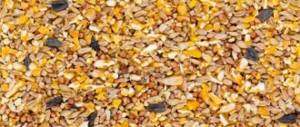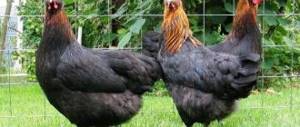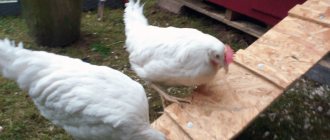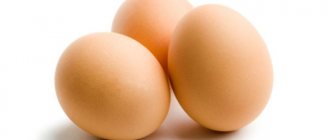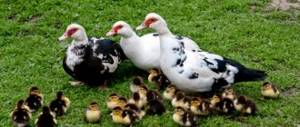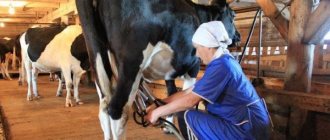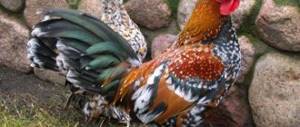Maintenance and care
The Jaerhyns breed of chickens should live in spacious poultry houses.
To save space, farmers use a multi-level perch system. Compact knockers can accommodate 4-5 heads per meter of timber. Free range will serve as an additional incentive to increase the clutch - in enclosed spaces and cage batteries it will be impossible to achieve such results. Although, due to their character, the birds are quite capable of tolerating cage housing.
Temperature readings are not the most important thing for cold-hardy flocks. Laying will continue even in severe frosts, but only if the poultry farmer has timely prepared for the onset of the harsh season
You should start insulating the poultry house even before the first frost hits. A properly insulated chicken coop will not only help maintain egg laying at a decent level, but is also the main preventive measure to protect the family from colds during the winter.
Winged beauties can be kept according to standard rules and recommendations. There are no special requirements for yaerhyns, but with the most correct approach to home arrangement, compliance with hygienic and preventive rules, safety will be significantly higher, and hens will be able to realize their full productivity potential.
Molting and oviposition break
Molting for an adult chicken will only be beneficial. Seasonal change of plumage does not bring any health consequences; on the contrary, the updated workers lay better and become stronger
But, it is important to be able to distinguish seasonal molting from pathological molting, which also occurs with various diseases
For example, the Jaerhyns breed of chickens sometimes go bald due to lice eaters or lack of vitamins. In addition, a herd may experience a problem such as cannibalism - because of this, they initially peck each other’s feathers, and then can peck each other to death.
Planned herd replacement
As mentioned above, black whales can lay eggs all year round and produce up to 220 eggs. This is approximately 20-25% less than modern egg-laying crosses. However, representatives of crosses and hybrids actively bear eggs only for 1-1.5 years, and Norwegian women do not lose this ability until their death, although from the third year the quantitative indicator decreases slightly.
Planned replacement of livestock can be tied to this age stage - it is advisable to raise the younger generation when the adult family has already crossed the three-year mark.
Frequent illnesses
Frequent diseases are not observed in feathered beauties - they have strong immunity, and resistance to cold makes them practically invulnerable. But, the family remains vulnerable to parasites and may periodically suffer from a lack of nutrients, especially in winter.
The most effective way to combat these problems is prevention - timely treatment of premises, monitoring the quality and nutritional value of the feed used and the health status of the poultry family.
Maintenance and care
The Oravka is a breed of chicken that was created to live in mountainous regions. It is able to withstand sudden changes in temperature and atmospheric pressure, without loss of performance or harm to health.
The main condition for keeping the winged family is the presence of a spacious poultry house and paddock, where they can waste their irrepressible energy and work up an appetite. Chickens cannot tolerate confined spaces, stale air and lack of activity.
The variety is frost-resistant and can withstand cold without getting sick. The recommended temperature inside the poultry house in winter is at least 5-7 degrees. This is necessary to maintain productivity.
In addition, you need to take care of the light regime - laying hens are sensitive to light, and if there is not enough light, activity in the clutch may significantly decrease. The remaining requirements are standard and no different from the rules for caring for other species.
Molting and break in egg production
Typically, most chickens molt in the fall, when daylight hours begin to decrease. But Slovak female dogs often delay this process and begin to shed only in winter. In principle, there is nothing terrible about this, and this feature is not dangerous to health.
But, it should be taken into account that during the molting period the functioning of thermoregulation mechanisms is disrupted. Birds can easily become hypothermic, and because of this, immunity decreases.
For this reason, it is necessary to take care of the warmth and normal microclimate in the chicken coop, and do this until the beauties’ fur coats are completely restored. Along with the restored plumage, egg laying should also resume.
Planned herd replacement
Good performance indicators are observed in the winged worker within 2 years from the moment she enters puberty.
Later, with each subsequent year, the number of testicles produced will decrease by 15-20%, and it is advisable to prepare for this moment in advance - to raise a generation of able-bodied young animals.
Frequent illnesses
Unfortunately, chickens are predisposed to respiratory diseases caused by viral infections. Therefore, poultry farmers create the most favorable conditions for the life of the family, which will prevent the weakening of the immune system.
Humidity should not exceed 55% - this is the main rule of prevention. In addition, it is necessary to monitor the nutrition of working women and prevent the development of vitamin deficiency.
Good luck and prosperity to you!
See modern products for poultry and livestock farmers that improve the health of pets and make our work easier.
Common diseases and control measures
An advantageous feature of this oriental breed is its high resistance to typical chicken diseases. Thanks to many years of natural selection that today's representatives of the Dakans have undergone, they have developed extraordinary immunity. Therefore, owners of these chickens practically do not have problems due to the spread of infections.
However, militant Asians experience frequent injuries. They are so designed that they cannot sit still without moving and fighting.
These pets are also sensitive to helminths and sucking parasites. Therefore, veterinarians advise taking care of the presence of sand-filled bathing suits , and also paying attention to the well-being of your pets. Signs of the onset of helminthiasis are indicated by:
- sharply absent appetite;
- inactivity and lethargy in behavior;
- noticeable weight loss;
- pallor of the comb and earrings;
- decreased egg production in laying hens;
- yellow diarrhea;
- labored breathing;
- ruffled chicks with lowered wings and lowered heads.
Read also: Instructions for using Enroflon for birds
The following drugs are excellent for the prevention and treatment of worms in chickens: Fenbendazole, Flubenvet, Ivermectin. Veterinarians advise using them according to the manufacturer’s recommendations, mixing them into food. To prevent the disease, it is not a bad idea to give medicine to your wards every six months.
Maintenance and care
Kulangi are an unpretentious breed of chickens that get along in almost any conditions. However, they are sensitive to cold climates: in warm regions these birds feel much better. Poultry farmers note a high survival rate of offspring; almost all chickens from a brood grow up to be healthy and strong birds.
The chicken coop room should be warm and dry, and it should be ventilated regularly. For bedding, it is best to use sawdust or peat. The walking area can be the same as for other poultry.
To keep dakans in comfortable conditions, you need to allow the birds to move freely. However, they should be protected from contact with other inhabitants of the poultry yard. Due to the cocky nature of this breed, kulangi are constantly in conflict, and for other breeds of chickens in your yard, fights can end in tears.
To properly form the muscles of the kulangs, they need to be fed correctly. Their diet has some differences from the usual menu of laying hens or broilers. On the one hand, they need to gain muscle mass and have a strong skeleton, on the other hand, uncontrolled nutrition can cause obesity, which is a disadvantage for a fighting rooster.
For up to one and a half months, Kulang chickens are fed boiled eggs, alternating them with cottage cheese. Finely chopped onions and nettles are given as a source of vitamins. For mature birds, the menu should look like this:
- 25% - boiled potatoes;
- 25% - compound feed;
- 50% - plant foods (clover, dandelion, alfalfa, burdock, nettle).
Kulangs are fully formed by the age of two, at which time they are released for cockfights. A few weeks before the competition, the rooster is placed in a separate enclosure and transferred to enhanced nutrition, the basis of which is cottage cheese and boiled eggs.
Content
A chicken coop for housing this breed must be well ventilated, dry and warm: this prevents the development of infectious diseases and the spread of pests.
Kulangi chickens are active and constantly moving, so the walking area should be spacious.
The laying hen takes care of the chickens. The most important thing is to ensure that the young animals are kept at a temperature not lower than +24 degrees in a room with sufficient lighting. The maintenance and care of young animals on the part of the breeder comes down to timely cleaning of feeders and drinkers and regular inspection of chickens for the presence of parasites.
The diet of adults is selected in such a way that the bird gains muscle mass and does not accumulate fat deposits.
The menu of an adult Dakan includes leguminous crops: peas, oats, wheat, buckwheat, barley, wet mash in fish or meat broth, curdled milk, fresh or boiled vegetables. In summer, birds are provided with grazing on green feed.
Roosters that are prepared for fighting are additionally fed with nut kernels, pieces of boiled meat or fish.
Chickens are fed boiled eggs mixed with cottage cheese, curdled milk and herbs. The diet of grown young animals consists of 25% boiled potatoes, 25% mixed feed and 50% plant foods.
- Stern
- Recipes
- Supplements
To hatch chickens, they practically do not resort to incubating eggs. The chicken copes well with incubation.
Table of temperature and humidity modes
Chickens of this breed practically do not get sick. If the conditions of detention are violated, they can be attacked by parasites. All health problems in adults are associated with injuries they receive during fights.
- Parasites
- Infectious
- Other
Video "Cockfighting"
Cockfighting is a traditional form of entertainment in Central Asia. How they go, see the next story (Azattyk).
- 5
- 4
- 3
- 2
- 1
- How to make a cage for laying hens with an egg collector with your own hands?
- Laying hens and Hisex chicks - white, brown, red
- How to build a chicken coop at the dacha with your own hands for the summer from scrap materials?
- Chicken of the Dominant breed, its characteristics and description
- Which dog suits your zodiac sign?
- The most dangerous foods for cats. It's better not to feed this
- How can hens and chicks get sick at home?
- All information about laying hen incubators
- Do chickens and chickens have legs that fail, what do they suffer from and how to treat them?
- Lyalya on Cat breeds that can boast of excellent health
- sogdy on Peaches, onions, mushrooms and 5 more foods that can harm your dog
- Yuri on 5 dog breeds that are better friends with cats than others
Prokyr.ru - Website about raising chickens with your own hands
Copying any materials without indicating the source is prohibited!
Peculiarities
All fighting breeds of chickens have some features that help defeat the enemy in battle. So, the birds have a vertical posture, a muscular body, massive paws with sharp spurs, a strong sharp beak, and a massive chest. All feathered fighters are united by their aggressive nature and endurance.
As a rule, fighting chickens are intended only for entertainment. Breeders train chickens from an early age so that they can later make money from cockfighting. By its nature, the fight between birds is cruel and unprincipled. It's like sparring between heavyweight boxers or fighting without rules. The birds fight each other until the strongest one wins.
Today, cockfighting is banned in Europe due to cruelty to animals, but underground clubs continue to exist. Once the young rooster is ready to fight, fighting takes place in the ring.
There are four known styles of fighting birds, depending on their behavior during an attack. It is produced in birds during regular training.
- Straight style. Seeing the enemy, the bird, without much maneuverability or stealth, swoops down on the opponent and hits him right in the head.
- Circle style. The feathered one does not strike immediately. The rooster circles around its victim, gradually exhausting it. Only then does the fight itself begin.
- A messy type of fighting. Here, the feathered fighters strike mainly from behind, aiming directly at the back of their victim’s head.
- There are also birds that use a stealthy style of fighting. They try to protect their head from blows, hiding it under the enemy’s wing or going to their feet. Usually this tactic brings success with regular training.
Purpose of cultivation
Fighting birds are bred specifically for cockfighting. The meat of such chickens is not eaten. The impossibility of growing broiler fighting animals is due to their muscular body. When heat treated, the meat of fighting birds will be tough.
Chickens are taught fighting qualities at an early age. One way to prepare a feathered fighter is constant training. Experienced cockfight organizers willingly share their bird training secrets
It is important to take the process of preparing an individual seriously, as this will allow you to release a good fighter into the ring and earn a decent amount of money from him
Maintenance and care
The plumage of fighting chickens does not fit tightly to the body, as a result of which the birds do not retain heat well
Therefore, when breeding birds for cockfighting, it is important to provide them with a warm room
It is also necessary to pay attention to the daily diet of birds. The food should contain a large amount of proteins, which promote muscle growth
If possible, it is periodically necessary to walk birds on fresh grass, from where they receive additional nutrients.
The room where birds are kept must be clean and dry. This measure will help protect chickens from infection with any bacteria.
Nutrition - feeding tips
Another area of care for “Chinese birds” is nutrition, here they are famous for their advantage - they eat very little, the traditional diet is quite suitable for them, although the birds prefer to feast on soft food.
The nutritional value of the diet in cold seasons should be higher, since energy is expended to maintain a stable body temperature. For example, in cold weather, the mash is made warm by mixing the ingredients with heated broth or other liquid.
It is important to add mineral mixtures to food daily, this is due to the high productivity of egg production and, therefore, the need for calcium. It is better to refrain from feeding premixes that are supposedly designed “to improve performance”; laying hens respond poorly to them, but most importantly, it is harmful for them
It is better to diversify the menu with various cereals or ready-made feeds
It is better to refrain from feeding premixes that are supposedly designed “to improve performance”; laying hens respond poorly to them, but most importantly, it is harmful for them. It is better to diversify the menu with various cereals or ready-made feeds
Breed Features
This breed is one of the sport chickens. Basically, kulangi have a decorative purpose. If they do get such a bird, it is certainly not for the sake of its productive qualities. Kulangs are extremely active and have an aggressive disposition. They respond well to various types of training to which cockfighting enthusiasts subject them. You can watch the video (Dakan fight) to see how this breed is trained.
https://youtube.com/watch?v=OXzjgkM6dgU
Breeding history
This breed has ancient origins. Chickens with a fighting character appeared in Central Asia at a time when people decided to domesticate wild chickens. Along with their productive qualities, people have discovered extraordinary athletic abilities in roosters. At first, cockfighting served as a kind of entertainment, and then grew into a real sport. This gambling and spectacular activity has found many fans all over the world, and certain rules and criteria for choosing the winner have appeared.
With the spread of cockerel competitions, poultry farmers became puzzled about breeding roosters. The main criteria when selecting birds for cockfighting were massive physique, strong bones and fighting qualities. The strongest and hardiest representatives of the poultry yard went through a strict selection - they were selected for breeding further offspring.
Fighting chickens are most widespread in the Samarkand and Bukhara regions, here they are called Kulangi. No less interest in this breed arose in Kyrgyzstan, but the same type of chicken is called Dakan by local residents.
Appearance
You can easily recognize these birds with a fighting character. Even compared to other fighting breeds, the Kulangi have a particularly warlike appearance. Their muscular paws are set wide apart and have distinctive spurs at the ends of their paws. The very first external difference is the elongated body, placed almost vertically.
The exterior of the breed is characterized by the following features:
- The head of this breed is small, slightly flattened on the sides - this feature helps to withstand enemy blows.
- The neck of Kulangi birds is long, slightly extended forward, and the wings fit tightly to the body.
- The entire body is covered with a dense layer of hard feathers.
- The color of the plumage is most often brown, black or salmon.
- The warlike image of the cockerels is completed by a small bent beak and a nut-shaped comb.
Here are a few more facts about the external features of kulangs:
- females of this breed have a much larger comb than males;
- males do not have earrings on their ears, while in chickens they are barely noticeable and lowered closer to the neck;
- the weight of females reaches 3.5-4 kg, while males weigh from 5 to 7 kg. However, there are roosters with greater mass;
- Kulangi grow very quickly: at the age of two months, chickens weigh 1 kg, roosters - 1.3 kg. This feature makes it possible to use the breed when breeding broilers.
Kulangi today - use
Today, this breed is practically never found on agricultural farms. And cockfighting has practically disappeared into oblivion. So you can only meet dakans among poultry farmers who have not yet forgotten the traditional pastimes of their great-grandfathers. Cockfighting enthusiasts organize competitions between their birds.
This breed of chicken is not used for domestic purposes. Chicken egg production is extremely low, no more than 100 eggs per year. Kulangi chickens mature very early, at 6 months. Although the birds themselves have a large build, their eggs are not very large, about 60 grams.
Description of the breed
A striking difference between this species and farm breeds is the almost vertical position of the body. This makes the animal much higher than egg-laying and meat chickens. On the long neck there is a small but very strong head. Various processes, ridges or lobes are underdeveloped, except for the brow ridges. Both the hen and the rooster have a very small, compact tail. In adults, the legs are long and almost vertical.
Most often they have a light yellow color. Chicks' feet may be brown or salmon-colored. No specific coloration is observed. The Uzbek Fighting Dog can have any plumage color, but most often it is some kind of mixed type with 3-4 colors. It is interesting that the plumage of a rooster is much brighter and more magnificent than that of a chicken. The beak is white or beige with small black spots on the top. Only the male Uzbek Fighting Bird looks like a fighting bird, while the chicken does not have such striking fighting differences.
Young Uzbek Fighting chickens are absolutely no different from other chickens. The only difference is that chickens put on their feathers much later than other breeds.
Despite the fact that chickens can grow and reproduce well in cold climates. Newly hatched chicks must be protected from cold and drafts.
The vitality of the breed is 88%-90% of all young animals, but farmers are in no hurry to raise these chickens en masse, preferring more productive breeds. Uzbek Fighting is intended for other purposes. Most often they are kept on small farm plots in Central Asia and Latin America. Actually, in the very “epicenters” of cockfights.
Diseases and prevention
Hamburg chicken, like any poultry, is characterized by non-infectious and infectious diseases.
Non-infectious include hypo- and vitamin deficiency. When compiling a diet, you may not keep track of the presence of some component.
With a lack of vitamins or minerals, problems begin: feather loss, inflammation of the eyelids, muscle weakness and the appearance of rickets. Therefore, fresh vegetables are added to the diet, as well as mash with fish and meat broth.
Bronchopneumonia is another non-infectious disease. It occurs due to temperature changes. Terramycin is prescribed for treatment.
Pullorosis can be classified as infectious. It is transmitted through the air. Typhoid is dangerous because it affects the stomach of the bird. The survival rate is low. Treatment is prescribed by a specialist. Based on the general picture of the disease, he prescribes certain antibiotics.
Preventive measures
To prevent the development of diseases, you must adhere to the following points:
- Maintain cleanliness.
- Vaccinate in a timely manner.
- Remove all uneaten food. They become a breeding ground for bacteria.
- Monitor the availability of water and its cleanliness.
- Carry out disinfection.
Fighting qualities of the Kulangi breed
Chickens of this breed have a nasty and scandalous disposition. They show aggression towards other animals and birds, but at the same time they obey their owner unconditionally and are perfectly trainable. This breed is considered one of the most trainable among fighting bird species.
Kulangi birds are brought to fights in homemade cages.
To improve the qualities necessary for a successful fight, experienced breeders recommend preparing roosters for the competition as follows:
- A month before the fight, remove the bird from the rest of the individuals.
- Feed with cottage cheese, eggs and boiled fish, diluting such a high-calorie diet with finely chopped greens.
- Every day, conduct training for 15-20 minutes, placing an opponent of equal strength next to the future fighter.
It is important to ensure that the bird is not overfed and its weight remains within normal limits, otherwise the cockerel will not make a good fighter
Egg production and meat performance of the breed
The Uzbek Fighting Dog cannot compare in productive indicators with common farm breeds.
Firstly, they do not have high egg production rates, which are characteristic of laying hens. A chicken of this species is capable of laying only 110-120 eggs per year; moreover, such eggs are not large in size and weigh no more than 60 grams. The egg color comes in two variations - white and beige.
Secondly, most often chickens of this breed weigh no more than 4 kg (sometimes roosters reach 7 kg), but this is the weight of a living chicken, which has very massive and heavy bones. So you shouldn’t expect productivity like from chickens of meat breeds.
Sexual maturity and egg production
As you already understand, Japanese black-coughs are not kept for the sake of obtaining eggs, since they are not very successful in this matter. They mature almost like all other laying hens, and begin laying eggs closer to 6 months. But this does not yet indicate the end of puberty.
Final formation and maturity is observed closer to 2 years of life.
It is impossible to call Japanese beauties good layers, since their productivity does not exceed 100 cream eggs per year. Moreover, all of them are not large - up to 50 grams, and in the dwarf case - up to 30 grams (up to 150 per year). Despite this, they are very tasty and healthy. In their composition and taste they resemble quail.
Egg production and sexual maturity
Asian laying hens cannot boast of early maturation, and begin to lay eggs at about 6 months, sometimes a little later. Sexual maturity occurs around 9 months. But this is not the most important thing, because representatives of this breed are rarely used as laying hens, because they are of little use in this matter.
In a year, the Dakan fighting queen is capable of laying no more than 100 eggs, so it cannot be called productive. Despite the fact that black whales are quite large, their eggs are of medium size - about 60 grams each, with a light, nut-colored shell.
Productive qualities
The productivity of the breed always comes into the background; the belligerence of the Kulangi is valued first of all. However, the weight of the fighting breed is not bad - 4.5 kg for roosters and 3-3.5 kg for chickens. Laying hens are characterized by late egg production; egg laying begins at 6 months of age. From fighting hens you can expect about 100 eggs per year with a creamy shell and a weight of about 60g.
Breeding history
This breed has ancient origins. Chickens with a fighting character appeared in Central Asia at a time when people decided to domesticate wild chickens. Along with their productive qualities, people have discovered extraordinary athletic abilities in roosters. At first, cockfighting served as a kind of entertainment, and then grew into a real sport. This gambling and spectacular activity has found many fans all over the world, and certain rules and criteria for choosing the winner have appeared.
With the spread of cockerel competitions, poultry farmers became puzzled about breeding roosters. The main criteria when selecting birds for cockfighting were massive physique, strong bones and fighting qualities. The strongest and hardiest representatives of the poultry yard went through a strict selection - they were selected for breeding further offspring.
Fighting chickens are most widespread in the Samarkand and Bukhara regions, here they are called Kulangi. No less interest in this breed arose in Kyrgyzstan, but the same type of chicken is called Dakan by local residents.
This breed of chicken is not used for domestic purposes. Chicken egg production is extremely low, no more than 100 eggs per year. Kulangi chickens mature very early, at 6 months. Although the birds themselves have a large build, their eggs are not very large, about 60 grams.
Features of care and maintenance of Kulangi chickens
Kulangi birds must be kept in a spacious enclosure.
One of the advantages of Kulangi chickens is that they are hardy and unpretentious to keep. However, they can tolerate heat more easily than cold weather. For this reason, individuals of this species are not recommended to be kept in areas with harsh climates. But in central Russia, Kulangi take root well.
In order for the livestock to grow well and the hens and cockerels to be in excellent health, it is necessary to create certain living conditions for them:
- Place the birds in an insulated coop with a good heating system in case of a frosty winter.
- Insulate the floor with dense bedding that absorbs moisture well.
- Equip the chicken coop with artificial lighting so as to extend daylight hours to 16-17 hours.
- Equip a good ventilation system in the area where birds are kept.
- Install sticks at least 1 m long in the chicken coop so that the roosters can sit on them.
- Set up a place for laying hens.
- Keep the chicken coop clean and the litter dry.
- Protect livestock from drafts.
- Provide the flock with enough food and water, and in the warm season take care of a place for walking.
In addition, it is important to observe the behavior of birds. Roosters that show aggression towards their fellow tribesmen must be isolated in time, otherwise they can harm both adults and chickens
Characteristics
The following quantitative indicators of chickens of the Kulangi breed are noted::
- Raised chickens at the age of about 8-9 weeks have a body weight of 0.95 kg, cockerels - about 1.3 kg;
- Live weight of adults: chickens - 3.2-3.8 kg, roosters: 4.0-7.0 kg;
- Completion of puberty occurs on day 215;
- Average egg production: 90 - 110 eggs per year;
- The average weight of eggs is 55-60 g;
- The shell color of all eggs is light nut;
- Low egg fertilization equal to 70%;
- Chick hatching occurs in 80-85% of cases;
- High chances of safety of young offspring: young birds at 9 weeks of age - 98%, adults - 97%.
To raise chickens of this breed, it is necessary to take into account all factors and determine the possibility of organizing the necessary, vital conditions. Residents of the northern regions are categorically not recommended to have Kulangi chickens, as this species simply will not survive the frosty winter.
First of all, you need to take care of the remoteness of roosters that behave aggressively towards other birds.
You also need to properly prepare the chicken coops, insulate the floor with peat or other moisture-absorbing elements, arrange “nests” for laying hens and install long (about 1-1.5 m) sticks on which the fighting roosters will sit. Provide chickens with 16-17 hours of lighting, as well as free access to open air.
Rules of maintenance and care
Despite the fighting characteristics and specific disposition of representatives of this breed, raising them is not particularly difficult, except for the need for a separate enclosure for overly pugnacious roosters. Keeping this bird is not troublesome if you know its characteristics and requirements for conditions.
Diet
Improper feeding of this warlike bird reduces the survival rate of the flock. Therefore, owners must clearly distinguish between food for chicks and for adults.
Young animals
According to experienced breeders, young kulangi in terms of nutritional diet are not much different from their other brothers.
It is recommended to give chickens:
- boiled yolk;
- fresh cottage cheese;
- porridge;
- cereals (semolina, millet, corn);
- raw and boiled vegetables;
- finely chopped greens (in particular, onions and nettles).
Learn more about the importance of greens in chicken nutrition and how to properly feed chicks green food.
This type of nutrition is indicated for young animals up to forty days of age.
It is important to increase the amount of feed offered as the chickens grow. For the proper formation of bones and muscle tissue, athletic Asians would benefit from bone or fish meal in their mash (can be replaced with fish oil).
Older generation
Adult dakans can already be fed based on their needs. Semi-annual individuals should consume at least 70% wheat, oats and rye, as well as about 30% corn and barley. During this period, the bird can be given greens, boiled potatoes and mixed feed. Also, she will not refuse any meat waste, mash steamed in meat broths and vitamin impurities.
Important! In order to prevent helminthiasis in adult hens and chickens, veterinarians advise feeding the flock monthly for 3 days in a row with a weakly concentrated decoction of chamomile, sorrel and birch buds.
In summer, kulangi must be provided with free-grazing space. In winter, it is recommended to germinate grain and add crushed dry leaves to the mash. Of course, this food should be served warm, but not hot. Adult chickens are fed three times a day, regardless of grazing. Don't forget that you are dealing with a sporting breed whose activity requires a lot of energy.
Light and thermal conditions
Although these birds have increased endurance, they will be more comfortable in an environment that is close to natural. A mild, dry and warm climate is the native element of these Asian fighters. Therefore, residents of the northern regions should first take care of having durable, insulated chicken coops with good ventilation and additional lighting. After all, for the comfort of these feathered charges, the daylight hours must be at least 15 hours.
In addition, an important feature for male kulangi is a separate enclosure. This is how you can save the lives of rivals who are always fighting among themselves and claim leadership.
Do not forget about the conflict nature of the breed and do not allow it to contact other brothers in your household, otherwise bloody fights will be daily until the last rooster. This nuance is important to consider when walking birds. If there are other animals nearby, then for its safety it is better to build a spacious enclosure for the kulangi.
Important! Regardless of the length of daylight hours, Dakan hens stop laying eggs in winter.
From the history of cockfighting
The sport first appeared in the 8th century. BC e. Fighting roosters have a tough temperament; they are aggressive and ferocious. In Ancient Greece, special amphitheaters were built to watch the spectacle. From the ancient Romans the fun passed on to the Europeans.
Cockfighting is one of the most popular sports
In the 19th century, the sport appeared in Russia. At the 1878 exhibition, fighting chickens became popular. Soon the Moscow community of poultry lovers was founded,
Russian Poultry Society. At the beginning of the 20th century, government authorities banned fighting.
In the 20th century, cockfighting was also prohibited in Europe and America. It was considered cruel to animals. Today, in France, Spain, countries of Asia and Latin America, breeds of fighting chickens are preserved and improved.
Gudan breed of chickens
Origin story.
It will not be possible to trace the fate of the bird in question from the very beginning. This is not easy, since it has been around for quite a long time and was bred before poultry farmers began to record their achievements in the field of breeding.
It is known that it was first described in detail in one of the French publications in 1858. But, before this, the bird was exported outside the country, it was presented in England and the USA. In America, poultry farmers highly appreciated the visiting beauty and officially standardized it in 1874.
The problem with the decorative chicken was that due to its similar characteristics, it was often confused and passed off as Polish and Crevecoeur. But, Gudan is a separate dual-use variety, universally suitable for the production of meat and eggs, and is also often bred as an ornamental bird.
Maintenance and cultivation
Ticks and lice eaters are very dangerous for this breed. It is necessary to constantly ventilate and disinfect the premises in which chickens are kept.
In addition, chickens should be examined to prevent infection of the brood with parasites. The Indian fighting breed is defenseless against them and may even die as a result of infection.
Since Indian Fighting Chickens have a sparse layer of plumage, it is important for them to provide a warm room for wintering. A warm climate will ensure high-quality egg production for chickens and protect them from diseases
This is extremely important given that this breed often develops asthma.
Early incubation is required, as preparation for battles takes about eight months. The breeding base for the new brood is selected in December.
For insemination, the rooster from the last brood is better suited because it has the highest quality of fertilization. Laying hens should be fed protein-rich food. Hens should start hatching eggs before the end of the year
It is important to take into account that chickens of this breed lay 40-50 eggs with short breaks
It is better to keep chickens warm and feed them every week with special vitamins and microelements that can be added to the water. The food for them will be monofeed and vegetable protein.
When the chickens are already ringed, it will be necessary to reduce the amount of protein feed and increase the amount of grain in the diet. This helps to increase the rigidity of the feather cover.
Frequent walking ensures the health of the birds and helps strengthen muscle tissue. They also need constant training.
When breeding Indian Fighting Dogs, we must not forget that due to their extremely aggressive nature, they must be kept separately from other breeds. There is often a need to isolate males from each other.
External characteristics
It is impossible not to admire the beauty of the winged Japanese. They not only have good combat characteristics, but also attractive external characteristics, the description of which will be discussed in detail below.
- First of all, a distinctive characteristic deserves attention - vertical fit and fairly tall height. Due to the elongated body, high legs and long neck, the height of the birds can reach about 60-70 cm.
- The body is rectangular, angular, muscular, but skinny in appearance. The back is flat, the chest and tummy are also without noticeable roundness, but with powerful muscles, protruding forward. The peculiarity is that there is no feathering in the center of the chest. The wings are long, narrow, adjacent to the body along almost the entire length.
- The neck is very long, on it is an elongated head with a wide forehead, a small red crest and expressive eyes, under overhanging brow ridges. The comb may have a nut-shaped or string-shaped shape. The earrings are underdeveloped, colored in the same shade as the face and comb - red. The earlobes are medium sized and oval in shape, with a reddish tint. The throat is not feathered.
- The plumage is absent in places - the tips of the wings, breast bone, and throat are exposed. The body is covered with a thin layer of hard, tightly fitting feathers. The tails are short.
- As for color varieties, there are no specific requirements in the standard, since today there are about 20 different options. The most common are white, black, wheat, blue, red-black, silver and piebald.
- The lower legs are very well developed and large. The paws are long, colored yellow or gray-yellow - it depends on the base color.
- As for weight indicators, they can vary greatly. Today there are three lines of Japanese combatants. The Ko Shamo breed of chickens is the tiniest, dwarf chicken has all the above-described appearance features, but weighs from 0.8 to 1.2 kg. Chu Shamo is a breed of medium-sized chickens whose body weight ranges from 3 to 4 kg. And finally - O Shamo is a breed of chickens, the most powerful and largest “fighters”, which can gain weight from 4 to 5 kg, sometimes more.
https://youtube.com/watch?v=VU2NRVNGz2Y
The Japanese winged bird is a wild, untamed species, with unpredictable behavior, predatory habits and a desire to keep everyone around it at bay. In order to keep these fierce warriors in your yard, you need to be able to isolate yourself and all living creatures that are nearby as much as possible from them.
Japanese beauties are famous for their courage and fearlessness - without fear for their lives, without hesitation, they rush at an enemy who may be larger than them and superior in strength. It should be noted that roosters are prone to aggression not only towards strangers. They can arrange bloody showdowns and battles for supremacy among themselves!
For this reason, from “junior” age, they are separated and kept separately so that they do not kill each other. In addition, breeders highlight excessive activity and curiosity, and also recommend regular training of warriors - this is the only way to curb their wild nature and control them.
These beautiful birds are easy to train; they can understand what is required of them and do it.
Description and characteristics of the Kulangi chicken breed with photographs
Even compared to representatives of other fighting breeds, Kulangi chickens have a particularly aggressive appearance. Their powerful paws with expressive spurs are always widely spaced, and the bird seems to be constantly ready to attack.
Chickens Kulangi.
Distinctive features of this breed are:
- elongated body, almost in a vertical position;
- dense hard plumage of the body;
- small head, somewhat flattened on the sides;
- long neck extended forward;
- wings tightly fitting to the body;
- small curved beak;
- nut-shaped comb.
The colors of Kulangi chickens are not striking in variety, and there are only three color options: brown, salmon and black.
The features that distinguish birds of this variety from other fighting breeds include the following factors:
- The size of the comb in females is larger than in males;
- Earrings in hens are very small and are lowered closer to the neck, but in males they are completely absent.
An adult cockerel weighs from 5 to 7 kg, and a hen weighs from 3.5 to 4 kg. But some breeders managed to raise individuals with greater body weight.
Chicken diet
There are practically no differences in the menu of young animals from the traditional one. Raising babies in the first week of life is the same as any other. They are fed boiled eggs, herbs, cottage cheese, and cereals (mainly corn, semolina and millet). And here are some tips for further feeding.
- Increase the amount of food as the babies grow.
- Add fish oil, but in measured quantities, because it can cause digestive upset.
- Make sure that the younger generation receives a daily large dose of protein and calcium necessary for intensive muscle and skeletal growth.
- Use vitamin supplements designed for growing babies. Also, don't forget to include plenty of greens in your diet.
- Do not forget to ensure that children always have access to clean and fresh water.
Feeding
Starting from the first day of life, chickens are given steamed crushed millet and corn with a boiled egg and chopped herbs. Cottage cheese is included as proteins. To feed the adult herd, a high-calorie and nutritious diet is chosen. They are suitable for ready-made mixed feed with a low fat composition, such as for eggs-producing birds.
In the warm season, be sure to include any edible grass or greens in your diet. In the fall and winter, chickens are given root vegetables and grass meal or pellets. It is necessary to enrich the diet of birds of this breed with vitamins and minerals.
- Stern
- Recipes
- Supplements
Compound feed pk-1
Description of food for egg breeds. Instructions for feeding laying hens Read
Compound feed pk-2 and pk-3
Mineral and vitamin compositions, feeding standards Read
Compound feed pk-4
Used to feed laying hens aged 15-17 weeks Read
Compound feed pk-5
Composition and instructions for feeding broiler chickens Read
Purina Pro
Important differences from the previous line, application patterns Start, Growth, Finish Read
Germination and steaming of barley and wheat for chickens: how to do it correctly and how to give it to laying hens
Wheat for broilers
Rules for feeding broiler chickens with wheat. Dosage for chickens from the second day of life and adult birds Read
Mash
Making mash for broilers at home Read
Rice and buckwheat
How and in what form you can use rice and buckwheat to feed chickens. Standards for adult birds and chickens Read
Bread
What kind of bread can you feed chickens and how to do it correctly Read
Fish
The product is given in limited quantities: overfeeding can cause serious harm to the bird Read
Chalk
Chalk as a food additive for chicken feed. Feeding standards for chickens, young animals and laying hens Read
Meat and bone meal
Meat and bone meal is a mandatory additive for feeding chickens, containing protein and fats of animal origin Read
Fish fat
How to give fish oil to chickens, layers and broilers. What are the benefits of the drug and are there any contraindications Read
Limestone
Limestone (dolomite) flour in the diet of chickens. Advantage over chalk and feed shell Read
Salt
Daily dosage of salt for adult birds and young animals and cases of unwanted use Read
